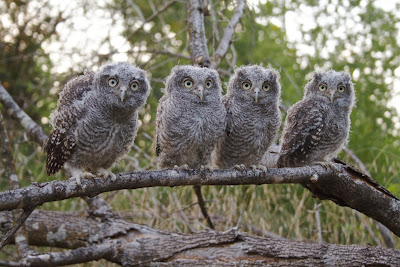A few people have asked for a status report. The owls and eggs are fine.
There. I hope you’re happy.
Expanding on that a little, we’re in the long, dull ~30 day incubation period. All four eggs look good (there’s been no opportunity to weigh or measure the last two, regretably). Mme. Owl is comfortable and, due to mild temperatures, can leave the box with some regularity, albeit not for long periods of time. Mr. Owl has been providing a steady supply of small food items ranging from geckos to cockroaches.
Ranting, with a Hint of Techno Status
So, everything is exactly as it should be, apart from the fact that there is no screech owl cam’, which is driving me nuts. I started with at least a plan A, B and C to make this happen, one way or the other. But every one of those plans has either failed, or is being delayed very effectively by the people who should be supporting their company’s customers, and do, it seems, right up to the point where a solution could result. If this persists much longer, I may find the energy to write a review of a company which we’ll just call SS for the moment, the defective product they sold me, but won't quite arrange to replace, and the smart, hard working technical support person I've been dealing with there, who nonetheless answers email maybe once a week (or not all) and phone calls even less often.
There was a plan D, too, which was to render the absence of the traditional cam’ pages more-or-less irrelevant, by offering streaming audio/video, instead. It appears that streaming video is a no-go. The solid offer to stream the video from campus that I had has failed to be realized. The commercial service USTREAM turns out not support any streaming audio/video standards. I mean real IETF standards, like my video server supports (RTSP/RTP in this case), not the things companies call standards because that sounds better than "some damn fool thing, created in secret with no danger of peer review, that we want you to use".
So, now I'm back to plan A, which I don’t like (especially now that I know how it behaves in practice – it was much better in theory), but which I’m getting very close to making work. (Maybe it'll work better than I expect. There are good reasons to believe and disbelieve that.) As far as I can tell, the really big, tricky code is complete and working. I just have to interface it to the traditional Owl Cam software in place of its previous video acquisition code, and declare victory. Easier said than done, of course, but, barring hideous, surprising problems, I think I can finish-up the work soon.
If it all works, the good news is that it should go on working, unmodified, for the foreseeable future, with no drivers or other software to go obsolete, no interconnects to discontinue, etc. (So, just for instance, Apple can’t screw me by creating FireWire 800 ports that, for reasons no one can explain, and Apple has refused to address for at least three years, aren’t backward compatible with FireWire 400, thus rendering all three of my video capture devices useless. Neither will they be suckering me into using QuickTime for Java [or anything even vaguely like it on any platform], which was a great idea in principle, a mess in practice, and a software deathtrap since they ceased maintaining it.)
Well, that’s me done venting for the time being.
A Question for Loyal Followers
Now, a question: I gather a lot of people like discussion groups associated with topics like the screech owl cam’. I can, for instance, set up such a group for this cam’ on Google Groups very easily, but I have no idea what people who care about these things care about, and therefore no idea what service would be a well-received choice. If you have thoughts on this matter, feel free to post a comment, or contact me by email (my address is on the screech owl cam main page, down near the bottom).
(Personally, I burned out on discussion groups back in the heyday of Usenet, but that’s just me.)
And Now, Owls
Here’s an MPEG-4 (".mp4") movie of an interesting food delivery on April 2nd (27.3 MB). The food is one of the mediterranean geckos that have so successfully populated this region of Texas, and which seem to be a favorite screech owl food. The really interesting thing, to me, is after the gecko is swallowed, Mme. Owl engages in unbidden preening of her mate’s head, the feathers on which he can’t preen for himself, of course. Offhand, I don’t remember ever seeing this behavior associated with a food delivery.
Male above, female below, just after a food delivery this morning.




























